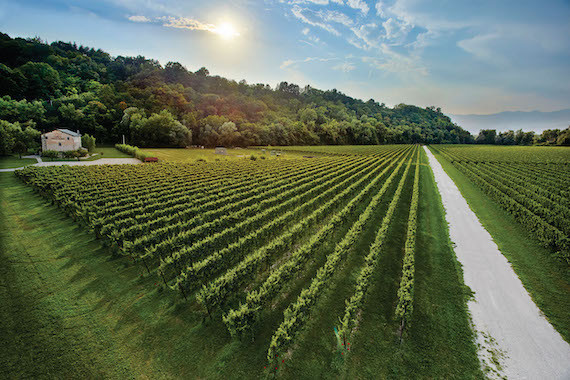In 2018, the producer received the Biodiversity Friend award from the World Biodiversity Association, and this commitment to sustainable practice is the core of its approach to creating robust and resilient vines.
“The aim is to create an environment in the vineyard that is as natural as possible,” says Geretto. “We have an insect hotel, which is like a five-star hotel for insects. We give them a home and they do a job in the vineyards eating other insects.”
There are also beehives on the property to help with wine vine pollination, and wooded and hedged areas that increase the number of insect and other animal species.
“All of these are proof of healthiness within the vineyard,” says Geretto.
AVOIDING CHEMICALS
Bottega has developed similar strategies to avoid chemical-aided farming. “All of our vineyards are organic, and we have cultivated them this way for 20 years,” says Bottega. “We have always thought that it is a must for the company to be sustainable in everything we produce.
“Eighty per cent of our vineyards are in the middle of forests with lots of insects that help with the fight against disease. We don’t use any glyphosate for cultivation, instead, we use a mulching system that uses the grape skin of grappa after it has been distilled. This allows us to protect the vineyards and fertilise naturally.”
Increasingly, viticulturalists are thinking of their impact beyond their acreage and turning to renewable energy, but to future-proof wine production, a rounded view is needed. Since Claude Bourguignon declared in 1988 that the soil of Burgundy’s vineyards was ‘dead’, growing numbers of producers have taken to biodynamic and organic practices, including those in the Prosecco DOC.
According to Geretto, a lot of praise can be directed towards the Prosecco consortium for its efforts to “obligate the producers to pay enough attention to the environment and their use of chemicals” in the region’s drive towards environmental responsibility.
“We are moving in the right direction; climate change has moved up the global agenda, and the consortium is embracing it and making the proper steps to encourage the right kind of practices,” says Smith. “The difficulty is with price-sensitive, mass-producing brands who can’t be doing anything to decrease already very tight margins. The difficulty is that they can’t exactly afford to embrace new technologies and innovations to be more sustainable.”
Affordability and sustainability are difficult concerns to find a balance between. Almost always, doing the right thing environmentally increases costs. In the context of Prosecco, whose massive appeal can be in no small part attributed to the value for money it represents, the scales are very sensitive.
“A sustainable approach is something producers must consider more now and in future,” says Janetzki. “Some sustainable practices can be implemented relatively inexpensively, while others require high investments.”
And sometimes the higher initial outlays will end up paying dividends.
“Even if we manage the company with a long view, vineyards which are cultivated with sustainable systems normally have a longer shelf life,” says Bottega. “Thirty years from now, our vineyards will be in perfect health and they will produce even better quality. It’s more costly but if we look to the future it will maintain the costs and the safety of the vineyards.”
If the unpredictability of recent vintages is anything to go by, Prosecco brands that invest in themselves, encourage the health of their vines and soil, renewably power their wineries and prioritise the long term, will endure.




